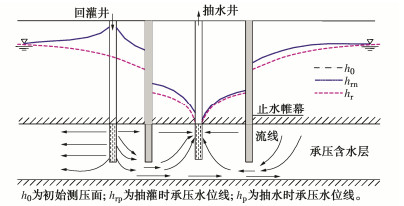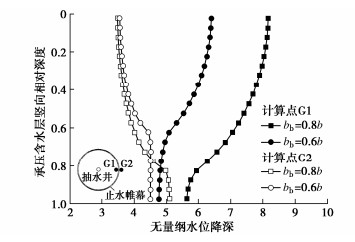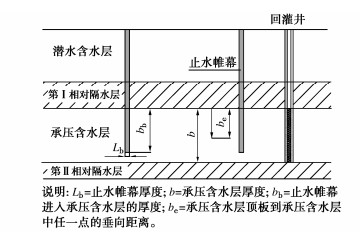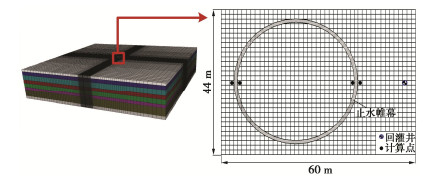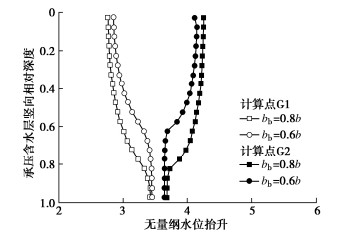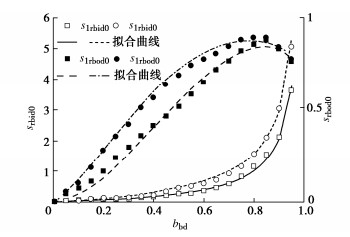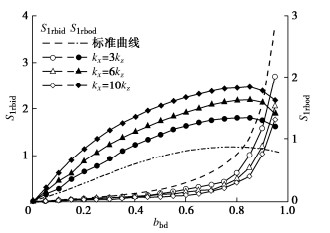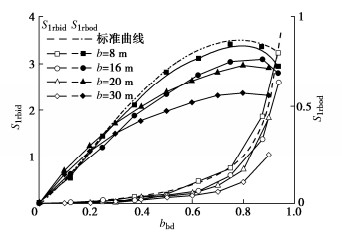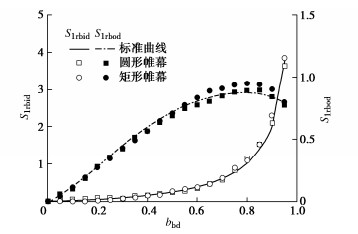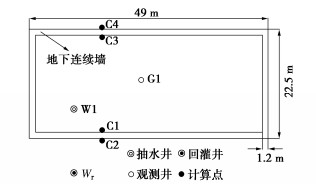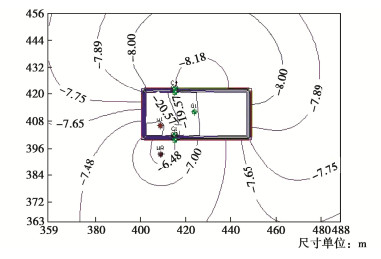Method for calculating pumping and recharging confined water inside and outside excavations under suspended waterproof curtain
-
摘要: 悬挂式止水帷幕下抽取坑内承压水时会对周边环境产生影响,地下水回灌能够有效控制坑外水位降深从而达到保护环境的目的。由于止水帷幕的存在,坑内外抽灌水使得基坑内外形成水位差。帷幕两侧水位差一方面是渗流方向和渗流路径的改变引起的,一方面是渗流面积减少引起的。通过数值模拟回归分析方法获得了基坑外回灌时帷幕两侧水位差的计算公式。将回灌时获得的水位差与笔者以往获得的基坑内抽水时止水帷幕两侧水位差的计算公式进行叠加,获得了基坑内外抽灌承压水时止水帷幕两侧水位差的计算公式。所提出的公式表明,帷幕两侧水位差与止水帷幕宽度及其进入承压含水层的深度、含水层各向异性、含水层的厚度以及无止水帷幕下抽灌承压水在帷幕处产生的水力梯度有关。最后通过工程实例对所提出的算法进行了验证。Abstract: The surrounding environment will be affected when the confined water in an excavation is pumped under a suspended waterproof curtain. The groundwater recharge can effectively control the groundwater drawdown outside the excavation so as to protect the environment. The existence of the waterproof curtain makes the head difference at two sides of the curtain during pumping and recharging of the confined water. The head difference is caused by the variation of seepage direction and path and the reduction of the seepage area. A series of equations to calculate the head difference during recharging outside the excavation are obtained by the numerical simulation regression method. The groundwater head difference during pumping-recharging action is the sum of the head difference during pumping and recharging, respectively. The proposed equations indicate that the head difference is related to the width of the waterproof curtain, the inserted depth of the waterproof curtain into the confined aquifer, the anisotropy of the aquifer, the thickness of the aquifer, and the hydraulic gradient under normal conditions. Finally, the proposed method is applied to a field case to verify its validity.
-
Keywords:
- waterproof curtain /
- confined aquifer /
- excavation /
- pumping-recharge action /
- head difference
-
0. 引言
随着中国交通行业的不断发展,中国桥梁建设水平得到大幅提升,对桥梁跨越能力的要求也不断增长,悬索桥作为所有桥型中跨越能力最大的桥型,越来越成为跨越大江、大河的主要解决方案。但是随着悬索桥跨度的不断增加,锚碇规模急剧扩大,造成锚碇建设成本过高。因此研究锚碇沉井基础的受力变形特性对于悬索桥的锚碇优化设计显得尤为重要。
Alampalli[1]在1994年研究了沉井在承受竖向和水平向荷载时的结构响应;李永盛[2]和李家平等[3]分别在1995年和2005年通过模型试验探讨了沉井基础的变形机制和破坏失稳形式;穆保岗等[4]在2017年通过模型试验研究了水平荷载长期作用下沉井变位的特性;Liu等[5]在2019年通过模型试验结合数值模拟分析研究了重力式锚碇的稳定性。
本文首先进行了在分级水平荷载下的沉井在砂箱中的模型试验,然后基于PLAXIS 3D软件建立了有限元模型,并分析了沉井的位移及沉井前侧和沉井底部的土压力,研究了水平荷载条件下沉井的受力变形规律。
1. 依托工程及模型试验
本文依托南京仙新路大桥北锚碇沉井工程,沉井长度为70 m,宽度为50 m,高度为49.5 m。该工程地基土以粉砂和中砂为主。
本试验采用的模型槽平面尺寸为4.0 m×2.0 m,高1.0 m。地基土采用中砂,其相对密度为2.68,最大孔隙比0.881,最小孔隙比0.463,不均匀系数3.89,曲率系数0.92。模型试验分层填筑地基土,控制每层填土的厚度为0.1 m,最终得到地基土的干密度为1.55 g/cm3,含水率0.63%,相对密实度为59.61%,内摩擦角为34.5°(快剪)。
沉井模型平面尺寸为0.7 m×0.5 m,高0.495 m,由厚度为22 mm的钢板焊接而成,试验过程将沉井看成刚体,不考虑沉井自身的变形,为模拟沉井与土体相互作用的界面,通过在沉井表面黏2~3 mm的砂粒实现[6],如图1所示。
模型试验中设计荷载为62kg,本文中水平荷载分级施加,每级荷载为设计荷载的~0.5倍,试验过程中每级荷载施加持续15 min直至土体破坏(土体破坏表现为沉井盖板处的位移急剧增大),沉井加载示意图如图2所示。
2. 有限元分析
本研究建立的有限元模型完全基于模型试验,土体及沉井的单元形状均为四面体十节点实体单元,数值模型的网格如图3所示。
砂土的本构模型采用土体硬化(HS)模型,土层参数[7]取值见表1。
表 1 土层参数Table 1. Soil parameters土层 γ /(kN·m-3)e Es /MPaErefoed /MPaEref50 /MPaErefur /MPac′ φ′ /(°)ψ /(°)m 砂土 15.6 0.723 10.2 10.2 10.2 30.6 0 34.5 0 0.5 注: γ 为砂土的重度;e 为砂土的孔隙比;Es 为砂土的压缩模量;Erefoed 为砂土的主固结加载切线刚度;Eref50 为砂土的标准三轴排水试验割线刚度;Erefur 为砂土的卸载重加载刚度;c′ 为砂土的有效黏聚力;φ′ 为砂土的有效摩擦角;ψ 为砂土的膨胀角;m 为砂土的刚度应力水平相关幂值。3. 试验结果与有限元结果对比
3.1 沉井顶部位移
在沉井盖板顶部设置3个位移测量点A、B、C。在位移测量点上放置位移靶标,采用TH-ISM-ST机器视觉测量仪对靶标位移进行测量,分辨率为0.01 mm,靶标布置如图4。
模型试验和数值模拟的位移对比如图5所示,由图易知,模型试验和数值模拟的靶标位移较为一致,本文中取水平位移随设计荷载增加而不断增加的线弹性阶段为水平承载力极限值[4],即安全系数取值为4。
3.2 沉井前侧壁土压力随施加荷载变化
在沉井前侧设置8个土压力盒,布置如图6所示,由于土压力盒对称分布,且沉井左右侧完全对称,因此取沉井左右两侧土压力盒平均值作为最终结果,结果如图7所示,其中模型试验中3号及3'号土压力盒数据较差,本文中已舍弃,余下的沉井前侧土压力盒数据和数值模拟结果较吻合。
3.3 沉井前侧壁土压力随施加荷载变化
在沉井底部设置12个土压力盒,布置如图8所示,同理,取沉井左右两侧土压力盒平均值作为最终结果,结果如图9所示,其中8号及8'号土压力盒数据较差,本文中已舍弃,余下的沉井底部土压力盒数据和数值模拟结果对比,发现当施加荷载/设计荷载的值小于等于4时较一致,当其值大于4之后,二者的结果相差较大。
4. 结论
本文在已有的研究基础上,通过开展模型试验和数值模拟计算,得到水平荷载下沉井的受力变位特性,主要得出以下结论:
(1)对锚碇沉井基础在砂土中的受力变位特性进行了试验研究和有限元分析,结果显示,水平荷载下锚碇沉井基础在砂土中的破坏模式为倾覆破坏,且安全系数远大于2,说明现阶段规范[8]中锚碇设计较为保守,有进一步的优化空间。
(2)通过PLAXIS 3D软件建立了锚碇沉井基础的有限元模型,采用应变硬化的本构模型,结果表明模型试验的结果和有限元模型计算的结果较为一致,说明数值建模过程中的土体本构模型及参数取值可靠,表明PLAXIS 3D软件能够较好的模拟锚碇沉井在砂土中的受力变形行为。
上述模型试验和有限元分析,只是针对水平荷载条件下锚碇沉井基础在砂土中的受力特性开展的研究,只考虑了单层干砂的地基土层,尚需更近一步探索。
-
表 1 模型计算参数
Table 1 Model parameters
土层名称 水文地质 厚度/m kx/(m·d-1) Kz/(m·d-1) Ss/m-1 ②粉质黏土 Aq0 3 8×10-4 5×10-4 1×10-6 ③淤泥质粉质黏土 5 5.1×10-4 2.7×10-4 1×10-6 ④淤泥质黏土 7 2.4×10-4 1.4×10-4 1×10-6 ⑤1-1黏土 AdI 5 3.03×10-3 1.74×10-3 1×10-6 ⑤1-2粉质黏土 6 2.5×10-4 1.17×10-3 1×10-6 ⑥粉质黏土 4 2.8×10-4 1.5×10-4 1×10-6 ⑦粉砂 AqI 10 3.6 3.6 6×10-5 ⑧粉质黏土 AdII 4 8×10-4 5×10-4 1×10-6 注:kx,kz分别为水平渗透系数和垂向渗透系数,Ss为储水率。 表 2 解析计算相关数值
Table 2 Relevant values of proposed method
Qw/(m3·d-1) r1/m r2/m r3/m r4/m i1ni1rn i2ni2rn 744 7.21 8.06 15.20 16.55 0.139 0.106 -360 9.53 8.49 27.65 28.90 0.070 0.027 表 3 回归公式法计算结果
Table 3 Calculated results by proposed method
条件 位置 符号 数值/m 抽水引起的水位差 C1、C2间 Δh1p 13.77 C3、C4间 Δh2p 10.51 回灌引起的水位差 C1、C2间 Δh1r 2.02 C3、C4间 Δh2r 1.02 抽灌共同引起的水位差 C1、C2间 Δh1 15.79 C3、C4间 Δh2 9.49 -
[1] 郑刚, 曹剑然, 程雪松, 等. 天津第二粉土粉砂微承压含水层回灌试验研究[J]. 岩土工程学报, 2018, 40(4): 592-601. doi: 10.11779/CJGE201804002 ZHENG Gang, CAO Jianran, CHENG Xuesong, et al. Experimental study on artificial recharge of second Tianjin silt and silty sand micro-confined aquifer[J]. Chinese Journal of Geotechnical Engineering, 2018, 40(4): 592-601. (in Chinese) doi: 10.11779/CJGE201804002
[2] 郑刚, 曹剑然, 程雪松, 等. 考虑承压含水层间越流的地下水回灌现场试验研究[J]. 岩土工程学报, 2019, 41(9): 1609-1618. doi: 10.11779/CJGE201909004 ZHENG Gang, CAO Jianran, CHENG Xuesong, et al. Field tests on groundwater recharge considering leakage between semiconfined aquifers[J]. Chinese Journal of Geotechnical Engineering, 2019, 41(9): 1609-1618. (in Chinese) doi: 10.11779/CJGE201909004
[3] 刘祥勇, 宋享桦, 谭勇, 等. 南通富水砂性地层地铁深基坑抽水回灌现场试验研究[J]. 岩土工程学报, 2020, 42(7): 1331-1340. doi: 10.11779/CJGE202007017 LIU Xiangyong, SONG Xianghua, TAN Yong, et al. Field tests on groundwater recharge of deep excavations in Nantong water-rich sandy stratum[J]. Chinese Journal of Geotechnical Engineering, 2020, 42(7): 1331-1340. (in Chinese) doi: 10.11779/CJGE202007017
[4] 陆建生, 潘伟强, 沈池, 等. 深基坑承压水抽灌一体化设计及工程应用[J]. 施工技术, 2014, 43(1): 48-52. https://www.cnki.com.cn/Article/CJFDTOTAL-SGJS201401016.htm LU Jiansheng, PAN Weiqiang, SHEN Chi, et al. Design and application on pumping-recharge integration system of deep foundation excavation[J]. Construction Technology, 2014, 43(1): 48-52. (in Chinese) https://www.cnki.com.cn/Article/CJFDTOTAL-SGJS201401016.htm
[5] ZHENG G, HA D, ZENG C, et al. Influence of the opening timing of recharge wells on settlement caused by dewatering in excavations[J]. Journal of Hydrology. 2019, 573: 534-545. doi: 10.1016/j.jhydrol.2019.03.079
[6] 李又云, 王欢, 苏世强, 等. 软土深基坑单井回灌参数优化与现场测试分析[J]. 地下空间与工程学报, 2021, 17(2): 520-528. https://www.cnki.com.cn/Article/CJFDTOTAL-BASE202102026.htm LI Youyun, WANG Huan, SU Shiqiang, et al. Parameters optimization and field test analysis on recharge well in deep foundation pit of soft soil[J]. Chinese Journal of Underground Space and Engineering, 2021, 17(2): 520-528. (in Chinese) https://www.cnki.com.cn/Article/CJFDTOTAL-BASE202102026.htm
[7] PUJADES E, LÓPEZ A, CARRERA J, et al. Barrier effect of underground structures on aquifers[J]. Engineering Geology, 2012, 145/146: 41-49.
[8] SHEN S L, WU Y X, MISRA A. Calculation of head difference at two sides of a cut-off barrier during excavation dewatering[J]. Computer and Geotechnics, 2017, 91: 192-202.
[9] WU Y X, SHEN S L, YUAN D J. Characteristics of dewatering induced drawdown curve under blocking effect of retaining wall in aquifer[J]. Journal of Hydrology, 2016, (539): 554-566.
[10] THIEM G. Hydrologische Methoden[M]. Gebhardt: Leipzig, 1906.
[11] KOZENY J. Theorie und berechnung der brunnen[J]. Wasserkraft und Wassenwirtschaft, 1933, 28: 88-92, 101-105, 113-116.
[12] 上海长凯岩土有限公司. 500 kV上海世博变电站工程群井抽水试验报告[R]. 上海: 上海长凯岩土有限公司, 2007. Shanghai Changkai Geotechnical Co, LTD. Report of group wells pumping test of 500KV Shanghai Expo Substation Project[R]. Shanghai: Shanghai Changkai Geotechnical Co, LTD, 2007. (in Chinese)
[13] WU Y X, SHEN J S, CHENG WC, et al. Semi-analytical solution to pumping test data with barrier, wellbore storage, and partial penetration effects[J]. Engneering Geology, 2017, 226: 44-51.




 下载:
下载:









